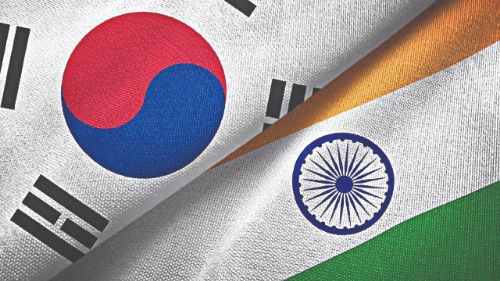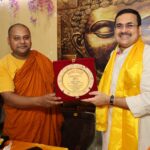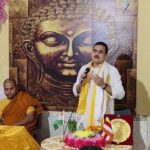Impressions of Korea
- By : Anirban Ganguly
- Category : Articles

Evolving over time, the civilisational connect between South Korea and India serves as the bedrock for a more robust bilateral relationship enriched with greater opportunities and engagements
There’s increasing interest and curiosity worldwide in the Bharatiya Janata Party (BJP). It is natural that this interest has increased over the years. During his extended tours across the country for organisational expansion, rejuvenation and ideological orientation, BJP national president Amit Shah would often remind us that in the coming years, the interest in the BJP would only increase and there would be a seeking from across the world to know the party, its history and functioning. Narendra Modi’s victory in 2014 saw a sharp rise in that interest.
A number of opinion makers, section of the intelligentsia and academics in the West have naturally woven their own narrative on the BJP, these are mostly negative and based on half-truths. These scholars have never met or interacted with members of the party, have never attempted to study its working nor have they engaged in serious or sustained dialogue with leaders and workers of the very party which they profess to interpret and describe. At best, they base their assessments on those who pass themselves off as experts on the BJP or on columnists and academic analysts, all of whom have little or no access to the actual workings of the party. Ironically, in the larger global intellectual sphere, these analysts have emerged as experts on the BJP. Their recognition and acceptance are dependent on the type of biases they can spread against the BJP and on the narrative of fear that they succeed in weaving around the party and its leadership. In the last fifteen years or so, these self-styled experts have continuously targeted Modi and have generated a huge corpus of biased and false propaganda on him and the BJP.
Post the 2019 electoral victory, BJP’s return to power with enhanced majority proved wrong these experts and their assessments. Narendra Modi’s governance narrative, his successful empowering of a vast section of the marginalised, his firm stand and defence of India’s national security, his successful and deft handling of international partnerships and opinions, BJP’s steady organisational expansion and overhauling, its multi-dimensional grassroots activism and outreaches saw the party convincingly return to power. This victory has further increased the interest in BJP and the narrative of its description is now going beyond the self-arrogated experts. There is a genuine interest in the party, in Prime Minister Modi’s leadership and in how the party succeeded in being victorious a second time.
Every vibrant, active, ideology and worker-based party, which has evolved through an ideologically driven political movement, must have a view of the world and must engage with it. Outreach to other political parties across the world, exchange of experience and ideas, a dialogue of positions and narratives, sharing of governance practises all must necessarily form part of political work in an era of greater and irreversible interconnectedness. The BJP has been actively engaged in such outreaches in the last five years. The intensity is set to increase post-2019.
A successful delegation visit led by BJP general secretary Arun Singh took place in August. It was an intense and multi-dimensional engagement and free and frank discussion took place at various levels. The second such delegation visit, in the second half of October, was to the Republic of Korea (RoK)–South Korea–and was led by BJP general secretary Muralidhar Rao. The Korean Foundation, at the forefront of research and outreach, invited the BJP to send its delegation and organised the meticulously planned visit. I happen to be part of the second delegation along with Vijay Chauthaiwale, in-charge of the BJP’s foreign affairs department and others.
The RoK is a natural partner for India. Our links are civilisational and have well-evolved in the last five decades — especially in the field of technology and industrial collaboration. The civilisational linkages have struck deep roots in our psyche. Its beginning is the legend of the Princess of Ayodhya (Ayuta), Suriratna (Heo Hwang-ok) who came to Korea and married the local king Kim Suro leading to the founding of the Karak Dynasty. The legend is ingrained in the Korean and Indian psyche. It is said that nearly ten per cent of the Korean people claim descent from that dynasty which had its roots in civilisational India. This is unique to our relationship; it imparts a different people-to-people approach among people of two nations.
In my quest to better understand civilisational linkages between Bharat and the countries and people of Southeast Asia, I often turn to that intrepid scholar, traveller and civilisational explorer Raghuvira, whose writings ought to come back to centre-stage in our present effort to weave a grand civilisational narrative for India. Writing on cultural relations between India and Korea, Raghuvira described the steady stream of Indian Acharyas, starting from the 4th century AD, who came to Korea through China, through one of the three Korean kingdoms, Kogooryuh which was “nearest to China” and therefore became the first to receive the “Indian religion from the Chinese mainland”.
When we visited the iconic Tongdosa Temple in the southern tip of RoK – the largest temple in Korea which just celebrated its 1374th year of founding, nestled in the lush and pristine Yeongchuksan Mountain amidst a thick pine forest – we absorbed a sense of this civilisational link. A UNESCO world heritage site, the Tongdosa Temple has a number of Buddha’s sacred relics enshrined in it and is a temple without Buddha’s statues. In course of our very interesting conversation with the venerable Head Abbot of the Temple, a figure of poise and grace, we were repeatedly reminded how, though Buddhism had come to Korea from China, China was only the passage, the corridor and it was India that had actually sent Buddhism to Korea and therefore India was sacred for them and it is to India that they looked up to. As we sat in the Head Abbot’s presence surrounded by the sacred mountains, bathed in twilight, in an all-encompassing stillness broken only by the sound of the gong emanating from the Dharma Hall, he told us how he had first visited India 40 years ago, how he continues to return every year. When told about the Buddha circuit that has been envisioned by PM Modi and how it is now being worked out, he expressed great happiness. Batches of students from the Tongdosa Temple visit India every year, to renew and to re-charge that civilisational connect as it were. This reminded me of those six Korean pilgrims who had, of yore, come and studied in India and on their return, “preached the Dharma in China and Korea”. Raghuvira lists the “pilgrim-teachers” whose names “should be enshrined in Indian history: Hecho, Heyup, Heryoon, Hyungak, Euijung, Hyunjo”. Among them, Hecho left behind a “description of his journey to the five regions of India, entitled, Wang-oh-chunchook gook-jun”. Raghuvira terms Hecho’s travelogue as an “invaluable jewel of ancient history” which should be translated in Indian languages and be made widely known in India. Such descriptions of India are necessary, especially as a counter to the colonial description of what we were.
Great scholars and Bhiksus such as the Sanskritist Wuncheuk (613-696 AD) of the Silla Kingdom, the legendary artist Solugh whose paintings “of Avalokitesvara and Vimalakirti were done in Indian style” and whose techniques were similar to those found in the Ajanta caves, further enriched this civilisational connect and exchange. It is said, that Bhiksus of all the three kingdoms in Korea, “wielded great influence in the country”. As Raghuvira writes, “They also imparted instructions in economics and politics, because they were well-informed about their country and about affairs in foreign lands. Their experience made their advice in affairs of the State an asset. At times, they were also sent abroad as envoys.” Interestingly, it is said that around the 8th-9th Century AD, “the Dhyana sect was introduced in Korea” and the “King and the Queen, the Prince and the Minister, the general and soldiers, all started practising Dhayana, not only for self-upliftment but also for cultivating intrepidity, bravery and fortitude”.
In Korea, Dhyana became, observes Raghuvira, “the substratum of life. In
palaces, huts and viharas, the young and the old learnt the art of concentrating the mind. Its basic principle was “active in quietness”, and “quiet in activeness”. This substratum of Dhyana, in a sense, still persists. The Head Abbot’s answer to our pointed question, that since nearly 50 per cent Koreans profess to be atheist, how he sees the future, was that it did not matter because the substratum of Korean society and civilisation was Buddhism and it was that which upheld values. “We have to all, stand on and cultivate our culture, which is the way ahead in ensuring our civilisational survival”, he told us in conclusion.
Gurudev Rabindranath Tagore further watered these linkages in the modern times, especially with his solidarity with Koreans then under colonial rule and through his immortal ode composed for Korea, expressing his hope that Korea’s lamp once “again shall be lighted for the illumination of the East”. One of Korea’s most well know poetess and Indologists, Kim Yang-Shik, describing Tagore’s poem and its impact on the Korean psyche writes, “Tagore’s poem is only four lines but the strong suggestion in his poem is enough to leave a deep emotion and a remarkable encouragement to Korean people at that time (1929)…The poem infuses confidence and hope even today in the minds of Korean people to march ahead towards a better future and one can easily imagine how much inspiration it would have given to them more than half a century ago when Korea was chained by foreign rule as India was”. More than a decade before he had composed these lines, Tagore had already become a household name in Korea, and “almost every Korean was aware of his contribution in the literary and philosophical fields.” That intensity for Tagore, a sense of collective gratitude for his solidarity and poem of hope continues to be deeply ingrained in the Korean psyche. Gurudev continues to be a vibrant civilisational link between us to this day. His name is mentioned with a sense of joy, elation and nostalgia in Korea. It is in these dimensions of the civilisational connect – Ayodhya-Buddha-Tagore – that lay the key for a renewed civilisational partnership – both intense, pragmatic and contextual.
The Koreans are proud of their achievements, especially their rise literally from ashes post-1953. The saga of their grit and determination, their work for national rejuvenation, the story of the growth and success of their industries which went on to become global brands such as Hyundai and Samsung are proudly narrated. The attitude that there shall always be bouncing back despite a slowdown, despite challenges and despite crashes, is something that dominates the Korean mindset. It gives people and policymakers a remarkable resilience and faith in their capacities. This has been a constant with Korea – the miracle on the Han River. In 50 years, the economy grew almost 300 times and was always labour oriented, capital oriented and innovation-oriented. Entrepreneurial giants such as Asan Chung Ju-Yung, founder of the Hyundai group showed the way ahead, they awakened the innate innovative and entrepreneurial capacities of the Korean people, “When we prosper, our country prospers; when our country prospers, we can prosper in turn”, Ju-Yung used to say. In post-war Korea, this had become the moving mantra. The first emphasis was given on building infrastructure since foreign aid would eventually discontinue, the emphasis was laid on creating a solid edifice of education, and initially, corridors of growth were eventually spread evenly across the country. We saw first-hand the values that drive these successful family ventures in infusing prosperity into Korean society when we’re taken to such units as Hyundai Heavy Machineries and Dongkuk Steel.
Technological ingenuity, creative prowess and educational advancement have defined their success. At the same time, a systematic movement for balancing urban and rural development was also launched. The Saemaul Movement for the renewal of every mind, renewal of every village, the Green Mind, Green Forest, Green Village movement saw the renewal and development of all of RoK’s 34,000 villages. An impressive interactive exhibition at the Global Knowledge Education Centre under the Ministry of Finance traces this fascinating growth story. Interestingly, the exhibition also displays a panel of challenges before the RoK, and one sees delineated on it such challenges as, lowest welfare spending, demographic imbalance – a rapidly ageing population with the elderly comprising 13.6 per cent of the population in 2016, North Korea has a higher birth rate we were told – socio-economic inequality, wage imbalance, lack of job opportunities, innovation slowdown, lack entrepreneurial mind-set, low welfare budget allocation for the elderly (2016), requirement of stronger small and medium-sized industries, etc.
At the Institute of Democracy, think tank of the ruling Democratic Party, there was a great deal of interest in the BJP and its functioning, in PM Modi, and in the 2019 elections. They described Modi’s victory in the 2019 elections as a “unique historical feat”. The cleansing of the electoral system, the elimination of the influence of black money in the electoral process was a decisive achievement of South Korean democracy and the discussion veered around that. A nuclear North Korea emerged as the single-most challenge, the older generation continues to remain nostalgic about unification, the younger generation also deliberates on what unification would mean to them in terms of lifestyle and opportunities.
For Korea, India is certainly the new frontier, a country with which they want to engage more and in which they see greater opportunities for engagement. They see Prime Minister Modi’s “Act East Policy” coalescing with President Moon’s “New Southern Policy” based on the “3P community” – a community of People, Prosperity and Peace. It was an educative exchange of views and political ideas, the scope for collaboration in research, especially in trying to synergise the ideas and vision of the “New Southern Policy” and the “Act East Policy”.
The unification narrative generates great emotions in Korea. The narrative has many shades and hues. We interacted with North Korean defectors, it gave us a first-hand account of an ideology-driven totalitarian communist regime and it’s functioning. Stories of mass starvation deaths of the 1990s in North Korea are similar to those of Mao’s China and the Odusan Unification Tower, near the 38th Parallel, the last station at Imjingkak have all been imaginatively conceived so that theme of partition and unification, war and strife, one people torn apart by ideology and geopolitical games can be narrated. The region is one of the most militarised zones in the world with 3 million live mines, and yet people flock in large numbers to get a feel of this narrative of partition. The yearning for unification remains strong, the nostalgia of an older generation continues to sustain and yet it is one narrative and
dimensions that have not been completely absorbed or come to terms with. The strains of the ‘Arirang’ – the folk song which has become the “unification song” of Korea because it is popular and is a song that is found and sung throughout Korea, still waters that unifying aspiration amidst the din of realpolitik and geostrategy.
It was an enriching visit. Apart from knowing a diverse and civilisation-consciousness country, it also provided us with an opportunity to speak on and describe how India was transforming, how the vision of a new India was rejuvenating and repositioning an entire nation as well as people; rekindling once more a civilisational consciousness.

















